CEE DOG
New member
Review: CarPro CeriGlass
Product Description:
Formulated with mild abrasives, CeriGlass deep cleans and polishes all glass surfaces with ease. It quickly removes acid rain spots, hard water spots, road film, stubborn bird stains, and interior glass film. CeriGlass is so effective; it even removes fine to medium scratches from glass! It leaves glass crystal clear and sparkling.
Introduction:
Until now I've never tried to polish glass with the object of actually removing scratches. I do however regularly use M105 or M205 to clean the glass when polishing a car. As you may know this works fine for cleaning the glass but paint polishes are designed to cut paint not glass, therefore they won’t remove scratches. It would be like trying to cut concrete with a plastic knife.
Until this product came along I had not had the inclination to attempt removal of scratches from glass. I considered it for my daily driver but the thought of polishing glass and the things I had read about its difficulty dissuaded me from placing it among my priorities. Not to say my windshield doesn’t seriously need to be either polished or replaced (as you will soon see).
There was a time when the last thing I ever thought about was caring for my vehicle. Years ago while in school and working a full time job my priorities consisted of working, studying, eating, and sleeping in that order. When you get 4 hours of sleep a night for an extended period of time you’re lucky if you even remember how you got from one point to another.
So back to the point! Years of not washing this poor soul allowed the sand under the wipers to drag against the glass and cause the damage at an accelerated rate. Many windshields have these types of scratches but on a lesser scale.
The chemical compound “silicone dioxide” (silica) is extremely hard and is used to make glass. In its natural state it’s found in quartz and of course sand. Therefore sand is often as hard as glass giving it the capability to leave scratches. By the time I started washing my vehicle regularly the damage was done and I lived with it… until now.
CarPros new product Ceri Glass is a water-based product, which contains no oils and utilizes the chemical compound Cerium Oxide along with other nano components.
Cerium Oxide is an off white colored powder that comes from a rare metal called Cerium. It’s used for polishing glass, polishing gemstones, and in self-cleaning ovens among other things.
Details:
1.- Packaging: Plastic bottle with well designed applicator nozzle and screw off lid
2.- Kit Option: Contains CeriGlass, 2 hand applicators, and a CarPro terry weave mf towel
3.- Viscosity: On the thinner side for a polish
4.- Color: Off White
5.- Scent: Didn’t detect any
6A.- Intro Price: 5.1 oz. (150ml) = $8.99
6B.- Regular Price: 5.1 oz. (150ml) = $10.99
7A.- Intro Price: Kit - $11.99.
7B - Regular Price: Kit – $14.99
8.-Manufacturer: CarPro
9.-Made in: Korea
Product
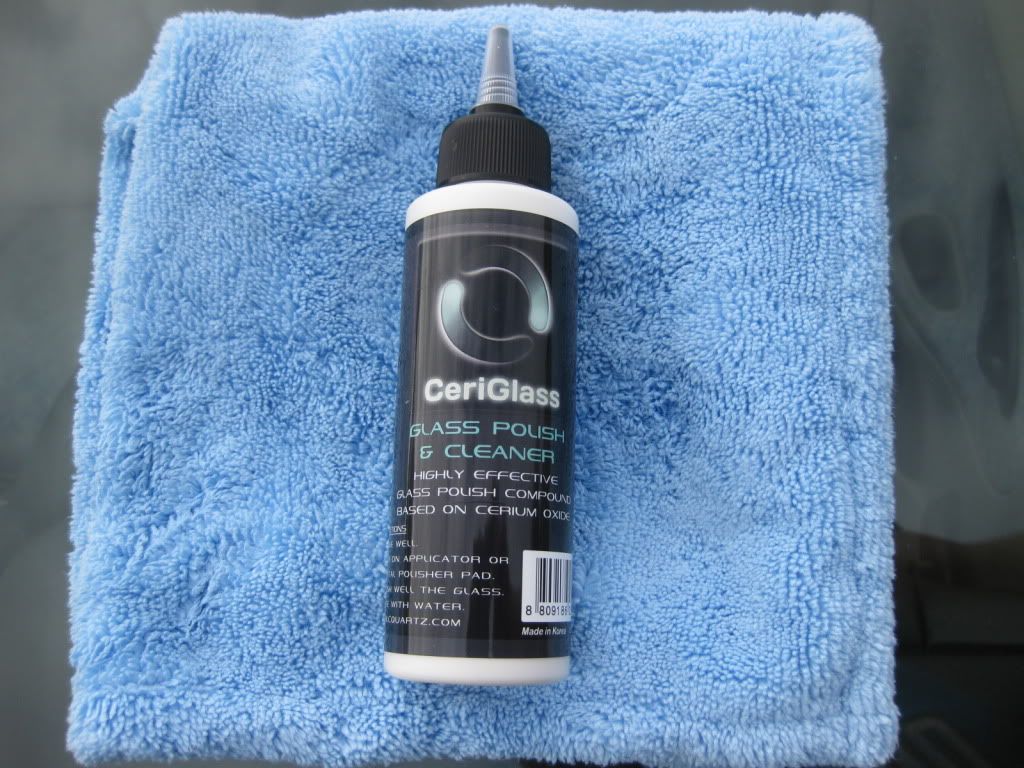

Small & Precise Applicator Nozzle

Precautions:
1.- Not for use on aftermarket window tint or painted glass
2.- For best results apply in the shade on cool glass
3.- Wear a facemask to prevent inhalation of polish powder
4.- Always try a test spot first
Instructions:
1.- Cover neighboring body panels and seals to avoid dust cleanup
2.- Shake the bottle well
3.- Apply small amount on the glass polish pad or hand glass applicator
4.- Buff thoroughly in circular motion
5.- Rinse the surface, wipe with mf towel and check results
6.- Repeat if necessary
Rotary Application:
For rotary application CarPro recommends a speed between 800-1000 rpm. I didn’t know this until some time after I first used the product so this led to some exciting experimentation on my part, which leads to the beginning of my adventure with CeriGlass.
Honestly my windshield was nothing short of a hazard that I’ve lived with for far too long. You can imagine what it looked like when aimed into the sun!
This was what I started with.
Video: Before
Before CeriGlass.wmv - YouTube




I had no glass polishing pads the first time I used CeriGlass but I was determined to give it a go so I retrieved my Flex PE-14 Rotary, a 6 1/2" Cyan HT pad and my CeriGlass. I had just finished washing all the cars so the glass was ready to be polished.
Cyan Hydrotech pad
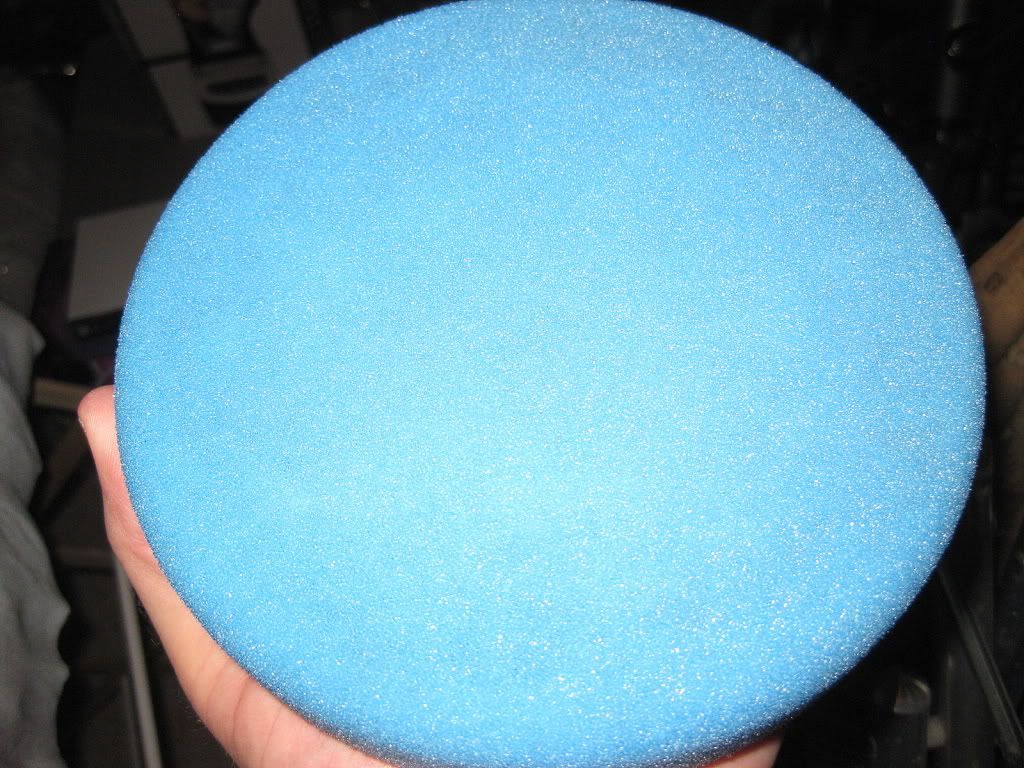
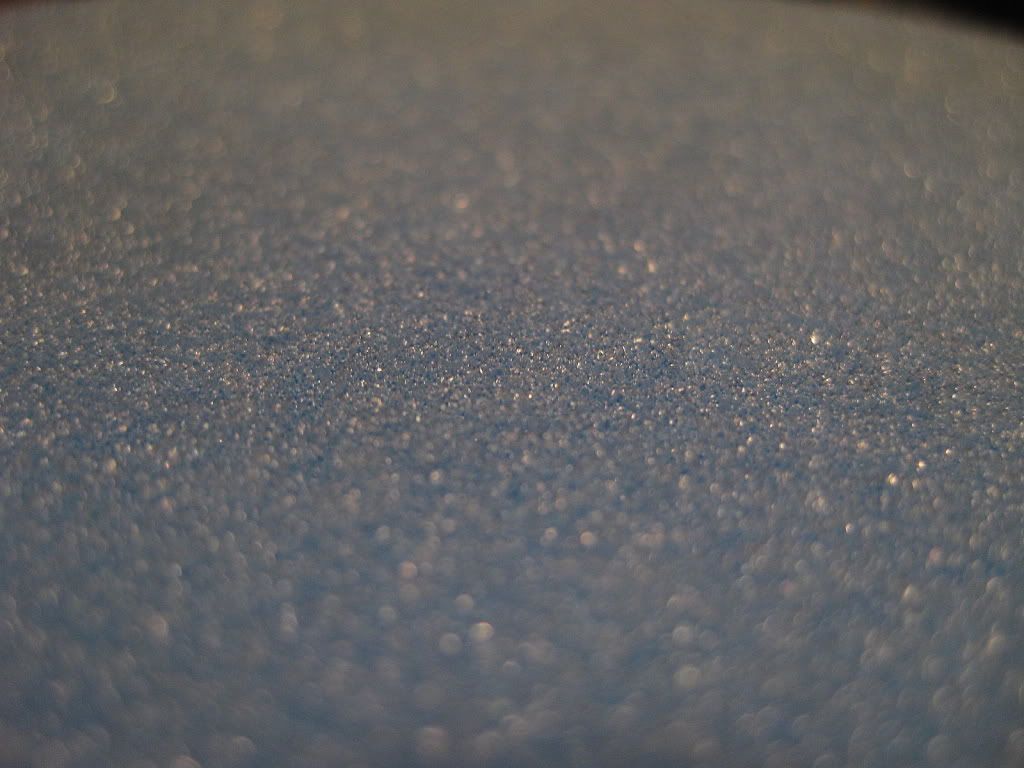
With no knowledge of how much product to use and the logical thought that foam cannot cut glass on its own I used an ample amount of product to start with. After spreading the product across the section I bumped the speed up to about 1800 rpm. (Note: CarPro recommends 800-1000 rpm) I applied fairly heavy pressure and slowly polished the surface until the polish started to dry up. At this point I misted my pad with water from a bottle and continued until once again it began to dry up. Finally I slowed the machine to about 1500 rpm and with one more mist of water and less pressure I finished it off.
Video: Rotary and Cyan HT pad in use
CeriGlass Rotary & HT foam pad.wmv - YouTube
For cleanup I used a wet mf towel and to my surprise found a big difference in the scratches on the side of the tapeline I had polished. I believe the fact that this is closed cell foam probably made a difference in its ability to remove scratches relative to an open cell foam pad.
It did not remove the scratches completely but the huge difference made it clear to me that with additional passes that could be achieved. I also figured (at the time) that if the foam pad had done this a glass polishing pad should do even better…
While the scratches were improved by probably about 80-95% this was difficult to see in the shade. What was obvious right away was the delineation where I had polished. The glass itself looked as though it was a different color, far more clean and transparent. When I did apply light to the subject the difference in the scratches really popped out at me!
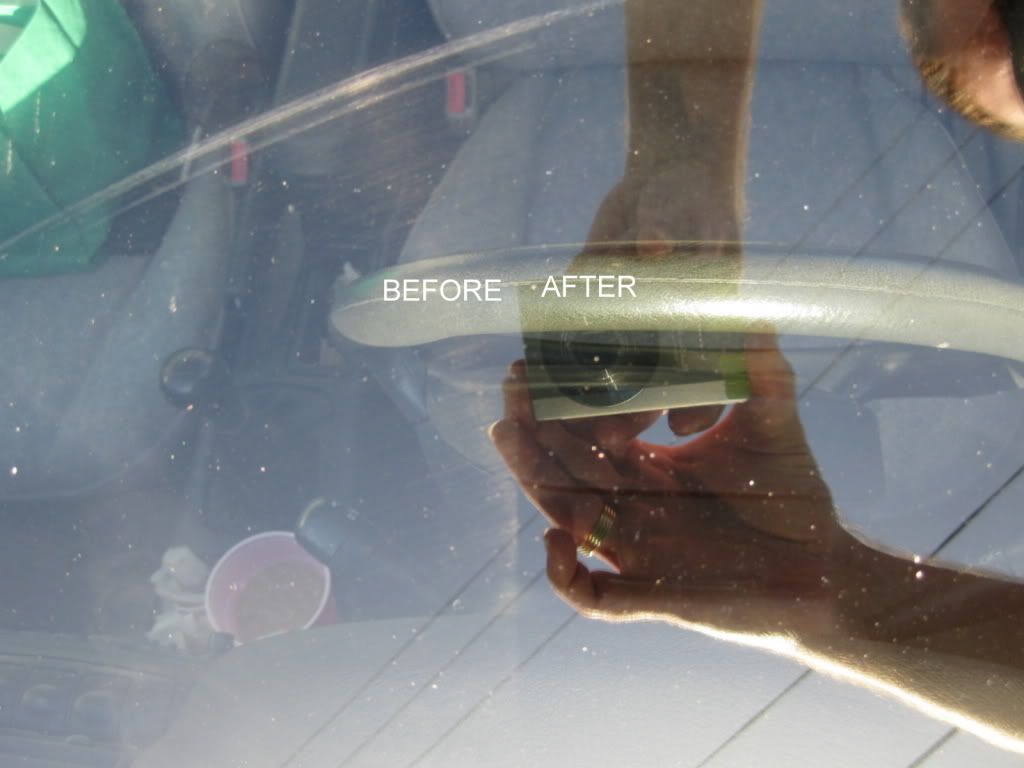
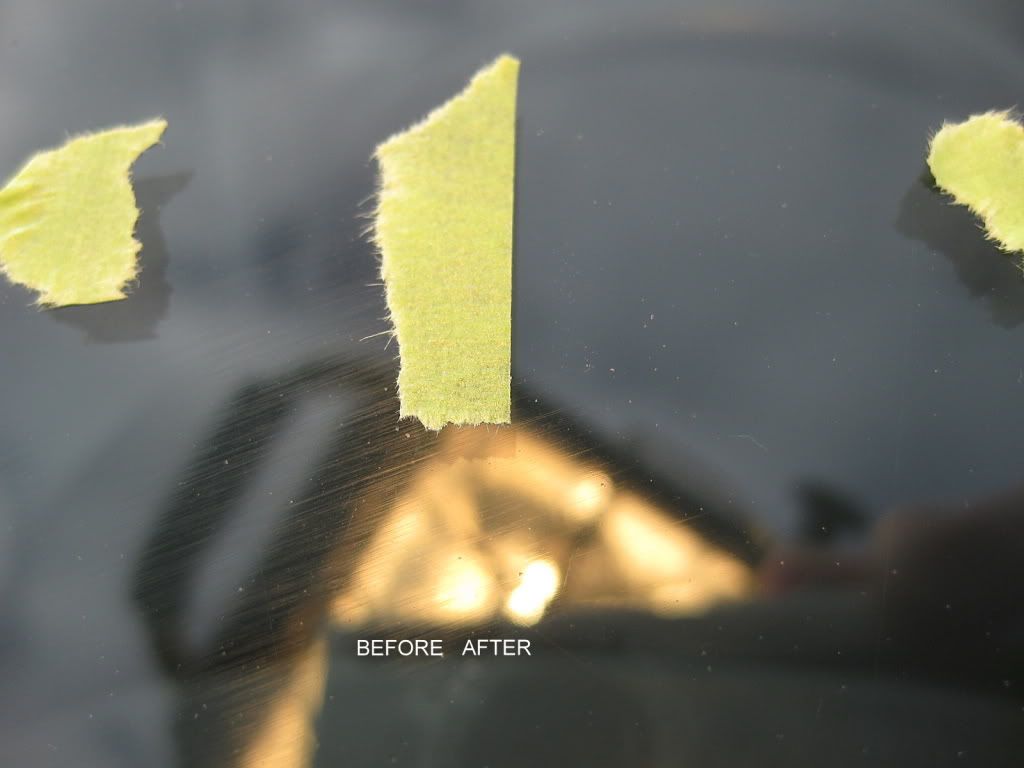
Video: Results Rotary and Cyan HT pad
CarPro Ceriglass Results 1.wmv - YouTube
After many futile attempts at photographing the scratches I decided to wait till later to take some 50/50 photos (and the video above) when a satisfactory light source in the correct location would present itself. Here are some 50/50 photos that were taken over the following days. Please excuse any dirt and dust on the glass.
50/50

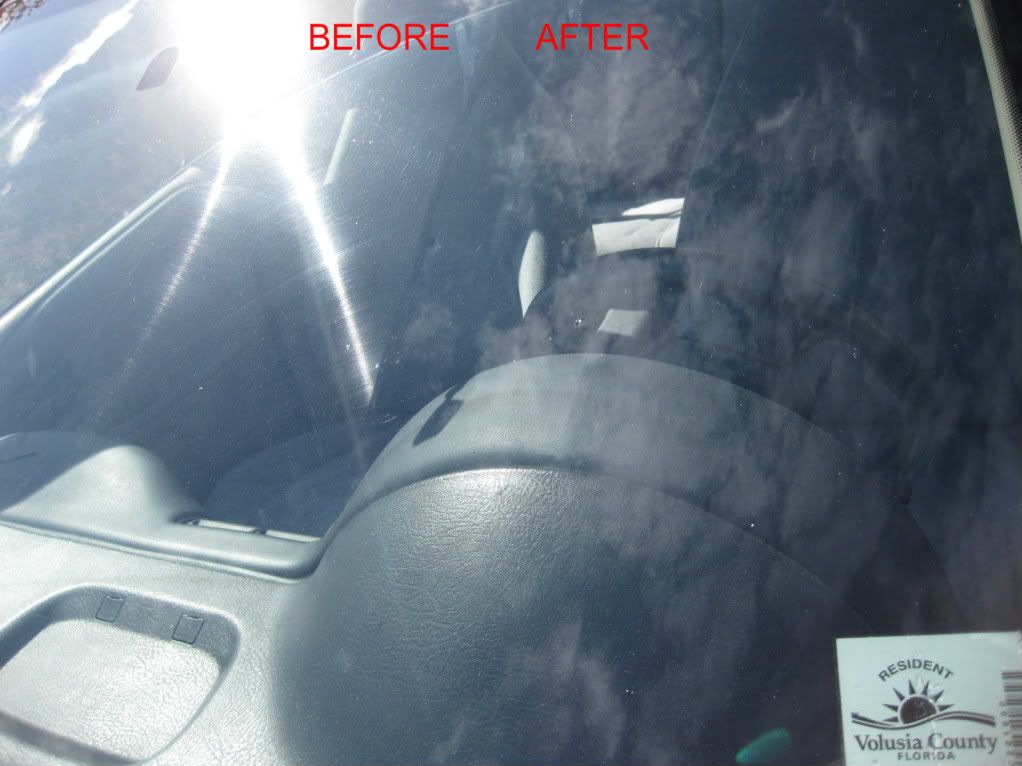








In my first go round with glass polishing I had really put an excessive amount of speed and pressure down and I had also neglected to spray water except for twice on the pad if I recall correctly. Checking the heat of the glass with my hand confirmed this. It was very hot! The heat generated by foam pads is certainly at least part of the reason CarPro recommends using a shorthaired wool pad such as this one.


CarPro mentions to rinse with water after completion of polishing. If by chance you did not follow their directions and (based on the pad, speed, and pressure you use) you end up heating the glass more than you should have I would allow the glass to cool a bit before applying a large amount of cool water to the surface. Just to note, you should not be allowing the glass to get that hot!
This brings me to an important subject which is keeping the surface of the glass as cool as possible. If you use glass polishing pads or the pads CarPro recommends heat should not be an issue but if you decide otherwise you should bring along a bottle of water to spray on the glass occasionally or as needed. In fact even with the use of the gpp which ran much cooler than foam I found a timely mist of water to be useful to keep the product from drying up and the machine running smoothly.
What you don’t want is to spray so much water that you start spinning slop all across the vehicle and yourself.
Random Orbital (Dual Action) Application:
Tuesday I saw AG announce the release of CeriGlass in the store so I hoped to get my review up asap. I rushed home after work to get some time with my new glass polishing pads and to see if I could remove scratches with a D/A. With the sunlight quickly leaving me, and no invitation from Sky to use her garage I got straight to it.
Unfortunately my glass polishing pads were smaller than my backing plate. But hey, who doesn’t like an adventure! J So, off I went with a tapeline across the windscreen, some Ceri on my new glass polishing pad, and my Flex 3401 quickly cranked up to 6… That is, after spreading the product of course.
Lake Country Glass polishing pad


I made multiple passes and wet the pad with a spray of water each time it started to get too dry. Finally I worked the polish through and applied a few more bits of CeriGlass to my pad for another round.
Video: D/A polishing:
CeriGlass with DA.wmv - YouTube
In total I spent about 10 minutes on the D/A section. By the time I was finished it was too dark to see so I cleaned up and put everything away for the night. Proper examination and pictures would have to wait until today…
Again there was a huge difference in the scratches as shown in the 50/50 images and video to follow.
Video: 3401 Dual Action Results:
CarPro Ceriglass Results with Flex 3401.wmv - YouTube
50/50


Hand Application:

I decided to get back at it before work this morning. After completing another section with the glass polishing pad (this time on the rotary) I thought it was time to try out the hand applicators.
CeriGlass can be purchased separately or as a kit. The kit contains the (2) hand polishing applicators as well as a “terry weave” microfiber towel.





Hand application cannot be expected to remove scratches. It may be possible with enough strength and determination but in my estimation scratch removal on glass should be left to a rotary or D/A. That doesn’t mean hand application doesn’t have its place however.
After you polish out every bit of the windshield or windows you are able to reach with your machine you ultimately come to a place where the corners of the glass are now a shade darker than the rest of the glass. Don’t worry! There’s an app for that! J The hand applicators come in handy for this application but I assume other hand applicators would fit the bill in a pinch.



While the hand applicators don’t allow you to remove scratches they do allow you to remove water spots and leave the glass very clean without the need for a machine.
Video: Rotary with Glass Polishing Pad followed by Cyan HT pad
As I mentioned above I started my Wednesday morning with a little more time in the driveway before I left for work. I was experimenting on a third section and using different amounts of water and polish. I thought I would throw a video in of that as well. Needless to say there were times when I used a bit too much water, which didn’t end up well for my dress pants. J
CarPro Ceriglass Rotary 2.wmv - YouTube
CarPro Wool Pad vs. Glass Polishing Pad vs. Cyan HT pad:
The “Lake Country glass polishing pads” I purchased are very flat but do not feel at all abrasive to the touch. As flat as they are I expected them to generate heat fairly fast but they did not generate nearly as much as I had expected. Maybe the cold morning air helped some as well.
They did not seem to correct the glass faster than the cyan HT pad I had used but then again the conditions were much different. With the cyan HT I ran the rotary on 1800 the first time around and used less water than I did with the gpp. The gpp I ran on 800-1400 for the most part.
To summarize my opinion of both options: The gpp is certainly the safer option as it doesn’t generate nearly as much heat as the foam pad. However I rather enjoyed using the cyan HT pad as it conformed to the surface much better. Once again I want to note I am not recommending anyone else use the foam pad since CarPro did not recommend it themselves. I’m only sharing my honest experience with it.
I have not used the wool pad CarPro recommends so I don’t know how well it would work with CeriGlass but I can say it would run cooler than the foam pad and conform to the surface better than the gpp. Next time around I think I’ll try my Tuff Buff wool.
Pros:
1.- Removes scratches from glass when paired with a machine
2.- Will not distort glass
3.- Price
4.- Polishes metals and hard plastic surfaces as well
5.- Applicator Nozzle: I love it and the screw on lid
6.- Water Based
???:
1.- Will AG carry the 16.9 oz. (500ml) in the future?
Cons:
1.- Removing deep scratches from glass would be a very time consuming process
Final Observations & Summary:
CeriGlass - Ceri (not to be confused with Siri) :doublesho is an excellent product that easily removes water spots and cleans the glass by hand or machine. What is of most importance to me is that it removes scratches with the use of a rotary or a suitable D/A. While of course it is not as fast as removing scratches from paint it is faster than I had expected and best of all relatively simple.
It took about 10 minutes of polishing time to remove most of the scratches and achieve those 50/50 shots on any given section. A rotary removes the scratches faster than D/A. I found this morning - Thursday - when driving directly into the sun (after I posted this review) that the section I had done by D/A did not have the scratches removed quite as well as the section with rotary and another go would be needed to catch up. Each section size was 1/4 to 1/6 the size of the total windshield. For fine scratches I assume they could be removed in 5 minutes per section with a rotary and a bit longer with D/A. All in all I thought it was relatively simple compared to what I had expected.
Many people warned me in the past that when dealing with Cerium I could warp my windshield among other things. I was happy to find CeriGlass was created with the right ratios of cerium and whatever other magical compounds they put in there to cause it to both cut glass and still be safe for the windshield on which I tested it.
I would recommend using a bottle of water to stop your pad from drying out but don’t over do it. One spray on the pad from 10” when the product starts to dry up or the machine stops moving as smoothly seems to work for me. And when it comes time, clean your pad and apply just a bit more polish.
CarPro also mentions it can be used for hard plastics and headlights. I’ve never dealt with a headlight that wasn’t easily polished with paint polish. So while I’m sure Ceri works great for that as well I personally have no need to use it that way.
What does excite me (beyond the glass correction function!) is that it can be used as a metal polish, which sounds very promising. I haven’t tried that yet but will be working Sky’s exhaust tips with it this weekend.
Honestly, now that AG has posted their prices I can’t imagine anyone wanting to pass it up for 9 bucks or 12 bucks for the kit. Btw, thanks to AG & CarPro on the pricing. I think that’s a good deal.
I’ll leave you with a before and after shot of the windshield.
BEFORE

AFTER

I don’t have the MSDS for CeriGlass but I do have it for one of the components. There didn’t seem to be anything to see there but I figured I’d post it in case anyone wants it.
Cerium (IV) Oxide MSDS - http://www.sciencelab.com/msds.php?msdsId=9923351
Product Description:
Formulated with mild abrasives, CeriGlass deep cleans and polishes all glass surfaces with ease. It quickly removes acid rain spots, hard water spots, road film, stubborn bird stains, and interior glass film. CeriGlass is so effective; it even removes fine to medium scratches from glass! It leaves glass crystal clear and sparkling.
Introduction:
Until now I've never tried to polish glass with the object of actually removing scratches. I do however regularly use M105 or M205 to clean the glass when polishing a car. As you may know this works fine for cleaning the glass but paint polishes are designed to cut paint not glass, therefore they won’t remove scratches. It would be like trying to cut concrete with a plastic knife.
Until this product came along I had not had the inclination to attempt removal of scratches from glass. I considered it for my daily driver but the thought of polishing glass and the things I had read about its difficulty dissuaded me from placing it among my priorities. Not to say my windshield doesn’t seriously need to be either polished or replaced (as you will soon see).
There was a time when the last thing I ever thought about was caring for my vehicle. Years ago while in school and working a full time job my priorities consisted of working, studying, eating, and sleeping in that order. When you get 4 hours of sleep a night for an extended period of time you’re lucky if you even remember how you got from one point to another.
So back to the point! Years of not washing this poor soul allowed the sand under the wipers to drag against the glass and cause the damage at an accelerated rate. Many windshields have these types of scratches but on a lesser scale.
The chemical compound “silicone dioxide” (silica) is extremely hard and is used to make glass. In its natural state it’s found in quartz and of course sand. Therefore sand is often as hard as glass giving it the capability to leave scratches. By the time I started washing my vehicle regularly the damage was done and I lived with it… until now.
CarPros new product Ceri Glass is a water-based product, which contains no oils and utilizes the chemical compound Cerium Oxide along with other nano components.
Cerium Oxide is an off white colored powder that comes from a rare metal called Cerium. It’s used for polishing glass, polishing gemstones, and in self-cleaning ovens among other things.
Details:
1.- Packaging: Plastic bottle with well designed applicator nozzle and screw off lid
2.- Kit Option: Contains CeriGlass, 2 hand applicators, and a CarPro terry weave mf towel
3.- Viscosity: On the thinner side for a polish
4.- Color: Off White
5.- Scent: Didn’t detect any
6A.- Intro Price: 5.1 oz. (150ml) = $8.99
6B.- Regular Price: 5.1 oz. (150ml) = $10.99
7A.- Intro Price: Kit - $11.99.
7B - Regular Price: Kit – $14.99
8.-Manufacturer: CarPro
9.-Made in: Korea
Product


Small & Precise Applicator Nozzle

Precautions:
1.- Not for use on aftermarket window tint or painted glass
2.- For best results apply in the shade on cool glass
3.- Wear a facemask to prevent inhalation of polish powder
4.- Always try a test spot first
Instructions:
1.- Cover neighboring body panels and seals to avoid dust cleanup
2.- Shake the bottle well
3.- Apply small amount on the glass polish pad or hand glass applicator
4.- Buff thoroughly in circular motion
5.- Rinse the surface, wipe with mf towel and check results
6.- Repeat if necessary
Rotary Application:
For rotary application CarPro recommends a speed between 800-1000 rpm. I didn’t know this until some time after I first used the product so this led to some exciting experimentation on my part, which leads to the beginning of my adventure with CeriGlass.
Honestly my windshield was nothing short of a hazard that I’ve lived with for far too long. You can imagine what it looked like when aimed into the sun!
This was what I started with.
Video: Before
Before CeriGlass.wmv - YouTube




I had no glass polishing pads the first time I used CeriGlass but I was determined to give it a go so I retrieved my Flex PE-14 Rotary, a 6 1/2" Cyan HT pad and my CeriGlass. I had just finished washing all the cars so the glass was ready to be polished.
Cyan Hydrotech pad


With no knowledge of how much product to use and the logical thought that foam cannot cut glass on its own I used an ample amount of product to start with. After spreading the product across the section I bumped the speed up to about 1800 rpm. (Note: CarPro recommends 800-1000 rpm) I applied fairly heavy pressure and slowly polished the surface until the polish started to dry up. At this point I misted my pad with water from a bottle and continued until once again it began to dry up. Finally I slowed the machine to about 1500 rpm and with one more mist of water and less pressure I finished it off.
Video: Rotary and Cyan HT pad in use
CeriGlass Rotary & HT foam pad.wmv - YouTube
For cleanup I used a wet mf towel and to my surprise found a big difference in the scratches on the side of the tapeline I had polished. I believe the fact that this is closed cell foam probably made a difference in its ability to remove scratches relative to an open cell foam pad.
It did not remove the scratches completely but the huge difference made it clear to me that with additional passes that could be achieved. I also figured (at the time) that if the foam pad had done this a glass polishing pad should do even better…
While the scratches were improved by probably about 80-95% this was difficult to see in the shade. What was obvious right away was the delineation where I had polished. The glass itself looked as though it was a different color, far more clean and transparent. When I did apply light to the subject the difference in the scratches really popped out at me!


Video: Results Rotary and Cyan HT pad
CarPro Ceriglass Results 1.wmv - YouTube
After many futile attempts at photographing the scratches I decided to wait till later to take some 50/50 photos (and the video above) when a satisfactory light source in the correct location would present itself. Here are some 50/50 photos that were taken over the following days. Please excuse any dirt and dust on the glass.
50/50










In my first go round with glass polishing I had really put an excessive amount of speed and pressure down and I had also neglected to spray water except for twice on the pad if I recall correctly. Checking the heat of the glass with my hand confirmed this. It was very hot! The heat generated by foam pads is certainly at least part of the reason CarPro recommends using a shorthaired wool pad such as this one.


CarPro mentions to rinse with water after completion of polishing. If by chance you did not follow their directions and (based on the pad, speed, and pressure you use) you end up heating the glass more than you should have I would allow the glass to cool a bit before applying a large amount of cool water to the surface. Just to note, you should not be allowing the glass to get that hot!
This brings me to an important subject which is keeping the surface of the glass as cool as possible. If you use glass polishing pads or the pads CarPro recommends heat should not be an issue but if you decide otherwise you should bring along a bottle of water to spray on the glass occasionally or as needed. In fact even with the use of the gpp which ran much cooler than foam I found a timely mist of water to be useful to keep the product from drying up and the machine running smoothly.
What you don’t want is to spray so much water that you start spinning slop all across the vehicle and yourself.
Random Orbital (Dual Action) Application:
Tuesday I saw AG announce the release of CeriGlass in the store so I hoped to get my review up asap. I rushed home after work to get some time with my new glass polishing pads and to see if I could remove scratches with a D/A. With the sunlight quickly leaving me, and no invitation from Sky to use her garage I got straight to it.
Unfortunately my glass polishing pads were smaller than my backing plate. But hey, who doesn’t like an adventure! J So, off I went with a tapeline across the windscreen, some Ceri on my new glass polishing pad, and my Flex 3401 quickly cranked up to 6… That is, after spreading the product of course.
Lake Country Glass polishing pad


I made multiple passes and wet the pad with a spray of water each time it started to get too dry. Finally I worked the polish through and applied a few more bits of CeriGlass to my pad for another round.
Video: D/A polishing:
CeriGlass with DA.wmv - YouTube
In total I spent about 10 minutes on the D/A section. By the time I was finished it was too dark to see so I cleaned up and put everything away for the night. Proper examination and pictures would have to wait until today…
Again there was a huge difference in the scratches as shown in the 50/50 images and video to follow.
Video: 3401 Dual Action Results:
CarPro Ceriglass Results with Flex 3401.wmv - YouTube
50/50


Hand Application:

I decided to get back at it before work this morning. After completing another section with the glass polishing pad (this time on the rotary) I thought it was time to try out the hand applicators.
CeriGlass can be purchased separately or as a kit. The kit contains the (2) hand polishing applicators as well as a “terry weave” microfiber towel.





Hand application cannot be expected to remove scratches. It may be possible with enough strength and determination but in my estimation scratch removal on glass should be left to a rotary or D/A. That doesn’t mean hand application doesn’t have its place however.
After you polish out every bit of the windshield or windows you are able to reach with your machine you ultimately come to a place where the corners of the glass are now a shade darker than the rest of the glass. Don’t worry! There’s an app for that! J The hand applicators come in handy for this application but I assume other hand applicators would fit the bill in a pinch.



While the hand applicators don’t allow you to remove scratches they do allow you to remove water spots and leave the glass very clean without the need for a machine.
Video: Rotary with Glass Polishing Pad followed by Cyan HT pad
As I mentioned above I started my Wednesday morning with a little more time in the driveway before I left for work. I was experimenting on a third section and using different amounts of water and polish. I thought I would throw a video in of that as well. Needless to say there were times when I used a bit too much water, which didn’t end up well for my dress pants. J
CarPro Ceriglass Rotary 2.wmv - YouTube
CarPro Wool Pad vs. Glass Polishing Pad vs. Cyan HT pad:
The “Lake Country glass polishing pads” I purchased are very flat but do not feel at all abrasive to the touch. As flat as they are I expected them to generate heat fairly fast but they did not generate nearly as much as I had expected. Maybe the cold morning air helped some as well.
They did not seem to correct the glass faster than the cyan HT pad I had used but then again the conditions were much different. With the cyan HT I ran the rotary on 1800 the first time around and used less water than I did with the gpp. The gpp I ran on 800-1400 for the most part.
To summarize my opinion of both options: The gpp is certainly the safer option as it doesn’t generate nearly as much heat as the foam pad. However I rather enjoyed using the cyan HT pad as it conformed to the surface much better. Once again I want to note I am not recommending anyone else use the foam pad since CarPro did not recommend it themselves. I’m only sharing my honest experience with it.
I have not used the wool pad CarPro recommends so I don’t know how well it would work with CeriGlass but I can say it would run cooler than the foam pad and conform to the surface better than the gpp. Next time around I think I’ll try my Tuff Buff wool.
Pros:
1.- Removes scratches from glass when paired with a machine
2.- Will not distort glass
3.- Price
4.- Polishes metals and hard plastic surfaces as well
5.- Applicator Nozzle: I love it and the screw on lid
6.- Water Based
???:
1.- Will AG carry the 16.9 oz. (500ml) in the future?
Cons:
1.- Removing deep scratches from glass would be a very time consuming process
Final Observations & Summary:
CeriGlass - Ceri (not to be confused with Siri) :doublesho is an excellent product that easily removes water spots and cleans the glass by hand or machine. What is of most importance to me is that it removes scratches with the use of a rotary or a suitable D/A. While of course it is not as fast as removing scratches from paint it is faster than I had expected and best of all relatively simple.
It took about 10 minutes of polishing time to remove most of the scratches and achieve those 50/50 shots on any given section. A rotary removes the scratches faster than D/A. I found this morning - Thursday - when driving directly into the sun (after I posted this review) that the section I had done by D/A did not have the scratches removed quite as well as the section with rotary and another go would be needed to catch up. Each section size was 1/4 to 1/6 the size of the total windshield. For fine scratches I assume they could be removed in 5 minutes per section with a rotary and a bit longer with D/A. All in all I thought it was relatively simple compared to what I had expected.
Many people warned me in the past that when dealing with Cerium I could warp my windshield among other things. I was happy to find CeriGlass was created with the right ratios of cerium and whatever other magical compounds they put in there to cause it to both cut glass and still be safe for the windshield on which I tested it.
I would recommend using a bottle of water to stop your pad from drying out but don’t over do it. One spray on the pad from 10” when the product starts to dry up or the machine stops moving as smoothly seems to work for me. And when it comes time, clean your pad and apply just a bit more polish.
CarPro also mentions it can be used for hard plastics and headlights. I’ve never dealt with a headlight that wasn’t easily polished with paint polish. So while I’m sure Ceri works great for that as well I personally have no need to use it that way.
What does excite me (beyond the glass correction function!) is that it can be used as a metal polish, which sounds very promising. I haven’t tried that yet but will be working Sky’s exhaust tips with it this weekend.
Honestly, now that AG has posted their prices I can’t imagine anyone wanting to pass it up for 9 bucks or 12 bucks for the kit. Btw, thanks to AG & CarPro on the pricing. I think that’s a good deal.
I’ll leave you with a before and after shot of the windshield.
BEFORE

AFTER

I don’t have the MSDS for CeriGlass but I do have it for one of the components. There didn’t seem to be anything to see there but I figured I’d post it in case anyone wants it.
Cerium (IV) Oxide MSDS - http://www.sciencelab.com/msds.php?msdsId=9923351
